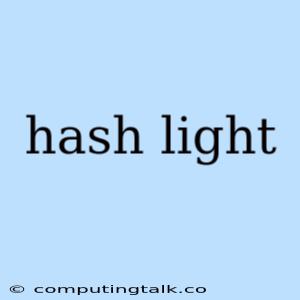Hashing is a fundamental concept in computer science, playing a crucial role in various applications. One common technique for hashing is the use of a hash light. But what exactly is a hash light, and how does it work?
Understanding Hash Lights
A hash light is not a specific type of hashing algorithm but rather a conceptual tool used to visualize and understand the process of hashing. Imagine a light that can illuminate different areas of a room, each area representing a specific hash value.
The hash light shines its light onto a key, which can be any piece of data like a string, file, or even an image. The light illuminates a specific area within the room based on the hash value generated from the key. This illuminated area represents the bucket where the key's hash value is stored.
How Hash Lights Work
Let's break down the process:
- Key Input: You start with a key, the data you want to hash.
- Hash Function: The key is processed through a hash function, which generates a unique hash value.
- Hash Light: The hash light illuminates the area in the room corresponding to the generated hash value.
- Bucket: The illuminated area represents the bucket where the key's hash value is stored.
The hash light helps us visualize how a hash function maps different keys to different buckets.
Benefits of Hash Lights
Using the hash light analogy provides several benefits:
- Visualization: It provides a clear and intuitive way to understand how hashing works.
- Collision Avoidance: The concept highlights the potential for collisions, where two different keys generate the same hash value, leading to the same bucket being illuminated.
- Efficiency: Understanding the hash light concept can help you grasp the efficiency of hashing algorithms.
Hashing in Action
Hashing finds applications in various areas, including:
- Password Storage: Passwords are often stored in a hashed form, making it difficult for unauthorized users to access them.
- Data Integrity: Hashing can be used to verify the integrity of files by comparing their hash values before and after any changes.
- Data Structures: Hashing is employed in data structures like hash tables, which provide efficient lookup operations.
Conclusion
The hash light analogy is a powerful tool for comprehending the concept of hashing. It helps us visualize how hash functions map keys to buckets, highlighting the importance of efficient hash functions to minimize collisions and ensure efficient data access. By understanding the hash light, we gain a deeper appreciation for the role of hashing in computer science and its applications in various fields.
